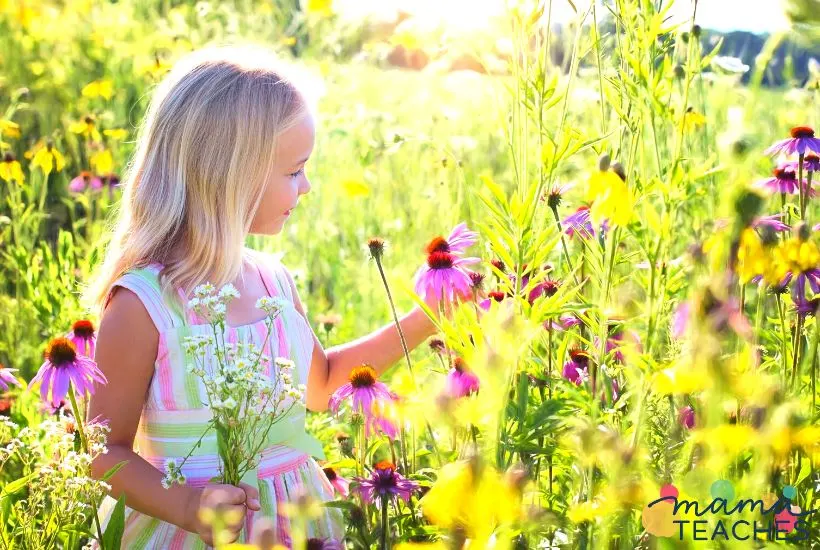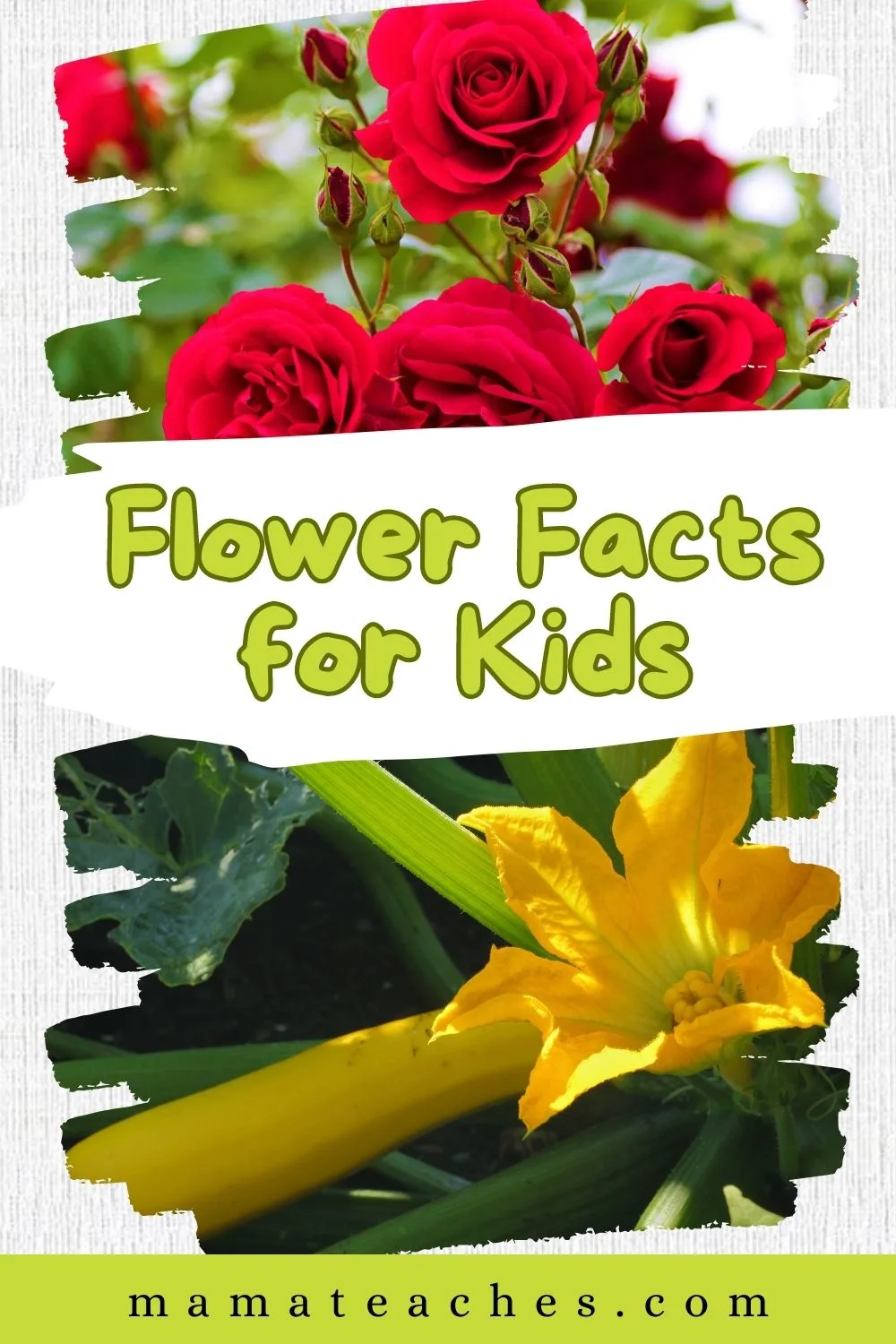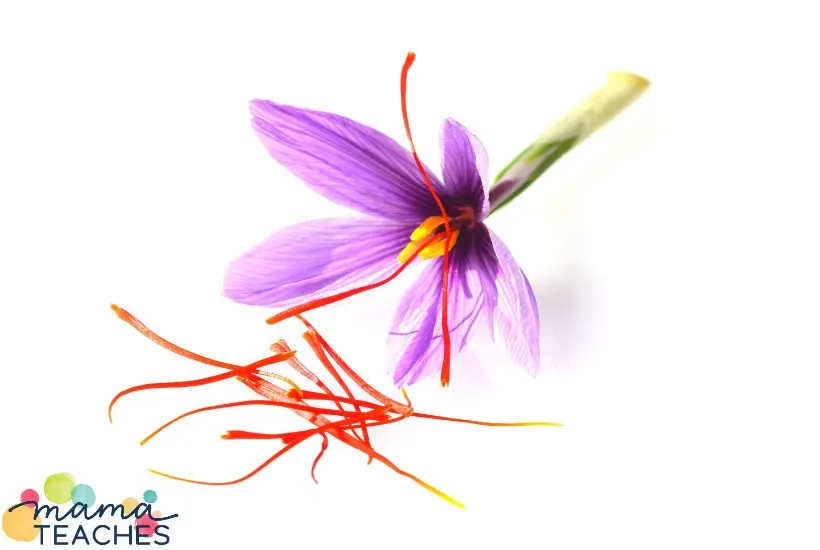Daisies, rose, lilies, and chrysanthemums: flowers are beautiful and intriguing. Find out more with these flower facts for kids.

Basic Facts About Flowers
Flowers are common but widely different from one another.
They can be large or small, full of petals or have only a few, and they can be every color imaginable.
The flower is the reproductive part of the plant.
The flower’s job is to attract pollinators like bees, butterflies, and wasps so that the plant can produce seeds.
Plants that have flowers are called angiosperms.
Now that you know some basic facts about flowers, let’s move on to some fun facts about flowers.

This article contains affiliate links to things that you might like.
Interesting Flower Facts for Kids
These flower facts for kids will have you looking at flowers in a whole new way.
1. Some Flowers Are Sweet; Others Are Poisonous
Many flowers produce a sugary liquid called nectar to attract pollinators.
Pollinators like hummingbirds, bees, butterflies, and fruit bats visit flowers to drink this sweet liquid.
In the process, they get pollen on their bodies and transfer it to other flowers. This fertilizes the flowers and allows them to produce seeds.
Have you ever tasted a honeysuckle flower? The sweetness comes from the flower nectar.
But don’t go around tasting flower nectar; some is poisonous.
Flowers such as rhododendron and mountain laurel have nectar that is toxic to humans.
In fact, the honey made from these plants can be toxic as well.

2. A Flower’s Scent Is as Unique as a Fingerprint
No two humans have the same fingerprints.
Similarly, no two varieties of flowers have the same scent.
Flowers produce scents to attract pollinators like insects.
The pollinators can recognize the scents of the flowers they prefer.
The most fragrant flowers are the ones that bloom at night since they cannot rely on their color to attract pollinators.
Moths chiefly visit night-blooming flowers since moths are nocturnal.
So the next time you smell the scent of a flower, you know that this particular scent is calling to moths at night!

3. You Can Order Flower Tacos
Although some flowers are poisonous, others are delicious and nutritious to eat.
Roses can be eaten raw in salads or dried and added to granola or tea.
Squash flowers can be stuffed with cheese and deep-fried.
Pansies can be added to salads or coated with sugar as a cake topping.
Dandelions are great in a salad; you can even make them into jelly!
Hibiscus and chamomile flowers are commonly used in herbal teas.
You can also fry hibiscus flowers and serve them inside a taco!

4. The Largest Flower in the World Smells Like Rotting Flesh
Rafflesia is the largest single flower in the world, measuring 4 feet wide. That’s about the size of a 7-year-old child!
You can find Rafflesia, also called the Corpse Flower, in the forests of Southeast Asia.
The plant is rust-colored with white dots all over it.
It produces a scent that smells like rotting flesh, but that is entirely on purpose!
The plant attracts carrion flies, which are its pollinators.
Carrion flies feed on rotting meat, so they climb inside the flower, looking for a dead animal. (But they won’t find one!)
In the process, they will get pollen on themselves and pollinate the next Rafflesia they visit.

5. Some Orchids Disguise Themselves as Bugs
Flowers can use their color, scent, or nectar to attract pollinators.
Some orchids use another method.
Their flowers look like female insects.
These plants are named after the insects they mimic: the fly orchid, the bee orchid, and the spider orchid.
The male insects will visit the flowers, thinking they are female insects.
By the time they realize the flower is not an actual female, they are covered with the orchid’s pollen. Mission success!

6. A Crocus Is More Valuable Than Gold
The saffron crocus has a center that is highly valuable as a spice.
You can find the saffron crocus in the Mediterranean region.
Saffron is highly fragrant and is a bright yellow-orange color.
Adding it to foods such as rice will color the rice a brilliant yellow and infuse it with a pleasing aroma.
Saffron is the world’s most expensive spice. By weight, it is more valuable than gold.
This is because saffron is costly to harvest. You must hand-pick 374,000 crocus flowers to make 1 kilogram of saffron.

7. Flowers Saved the Scots from the Vikings
According to legend, a band of Vikings landed on the shores of Scotland one night in the 1200s.
They intended to sneak up on the town and catch the Scots unaware.
The Vikings removed their shoes to approach quietly.
Unfortunately for the Vikings, the ground was covered with wild thistles, whose stems have thorns.
They stepped on the thorns and cried out, awakening the town and giving the Scots a chance to grab their weapons and defend themselves.
The thistle has been the national flower of Scotland since the mid-1400s when it was emblazoned on their money.
It is the oldest national flower.

8. There Is a Flower Language
Flowers don’t speak to one another, but people have used flowers to communicate secret messages for thousands of years.
This was especially popular during the Victorian era when people would give bouquets to communicate a meaning or intention.
Here are some flower meanings:
- Begonia – “Beware”
- Baby’s breath – “Eternal love”
- Butterfly weed – “Let me go”
- Pink carnation – “I’ll never forget you”
- Daisy – “I’ll never tell”
- Gardenia – “You’re lovely”
- Ivy – “Friendship”
- Marigold – “Jealousy”
- Red rose – “I love you”
- Tansy – “I’m declaring war”
The colors of flowers are also significant. Roses come in many colors, and the colors all have different meanings.
White stands for innocence, red for romantic love, dark red or crimson for grief or mourning, and yellow for jealousy.

Read More About Flowers
If you are intrigued and entertained by these flower facts for kids, check out these books for more fun facts about flowers.
How to Speak Flower
Learn more about the language of flowers with this colorful book of flowers, quizzes, and charts. Best for upper elementary and middle school.
The Flower Alphabet
This book teaches the letters of the alphabet with flowers from around the globe.
Ultimate Explorer Field Guide: Wildflowers
This fact-filled guide will help you spot and identify your native wildflowers.
